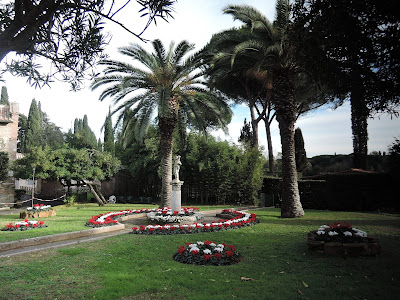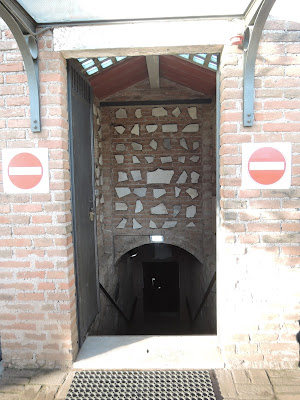As the skies had cleared we decided today would be a good day to attempt to see the Via Appia Antica, The Appian Way. Via Appia, named after the Roman censor, Appius Claudius Caecus, who built the first part of the road in 312 BC. It is one of the earliest roads to Rome. Part of that original road exists today! The Bus 118 did finally come and we thundered along the cobbled rocks/stones which comprise the oldest part of the road. A bottom shattering experience! I don't think it was that the bus had no suspension but rather it was the rough road which gave us a memorable ride! Not entirely sure where we were to alight, we took the bus all the way to Appia, which looks like a relatively modern residential suburb, waited for the bus to start on its return journey and hopped off at the small visitor centre. The visitor centre was closed for lunch so we followed the signs to the Catacomb of Callixtus and this was a good thing as we had inadvertently gone to the largest catacombs of Rome!
 |
| Catacombs were just around the corner! |
 |
| Exploring fields above the catacombs - possibly an old entrance. |
 |
| An ancient structure fitting into the landscape! |
There are 60 or so catacombs which were
used as graveyards for early Christians who were forbidden to practise
their faith. Tim, Luke and I decided to go on a guided tour which was
the only way to see inside the catacombs. Our guide told us that the
word Catacomb came from the Greek word for quarry. The Christians used
many metaphors and symbols to talk to each other about their faith and
this was another example of their "code" of communication. "We are just
off to the quarry", where they were able to hold masses in safety.
 |
| Maclura Pomifera - a strange green "brain" fruit we found on the ground. Thought to have been eaten by some prehistoric animals but not really eaten these days, soft and latexy inside, not aromatic. |
 |
| Aha! Another entrance to the catacombs! |
 |
| Sun getting low and it's only 2.15 PM! |
 |
| Clouds and umbrella tree! |
 |
| Red and white cyclamens at the entrance to the catacombs. |
The
Catacombs of Callixtus were the burial site for 9 popes and 60 or so
martyrs as well as families. They were no longer used from 9th century
as by then Christians were permitted to be buried in churches. It
wasn't until 1854 when Giovanni Battista de Rossi, an Italian
archaeologist, discovered the catacombs that they were opened again, a
thousand years after they had been sealed! The frescoes and relics were
still all there. The catacombs covered a distance of 20 kms and were
made by "reverse" architecture as the builders dug through the tufa,
volcanic ash to make the tombs. We were 12 metres underground in
structures which had been carved out over a thousand years ago and were
still stable!! Tufa, when exposed to oxygen, hardens. The acoustics
and arches, frescoes and rooms were all fascinating. Elisa, our guide,
showed us the many symbols Christians used such as the fish (Icthus),
Jonah and the whale (to represent Christ's resurrection after 3 days), A
young boy with a lamb, representing the story of faith in Abraham and
Isaac, a dove with an olive branch and a few others, some of which we
had seen in Ephesus.
 |
| Symbols used by Christians |
 |
| Plan of the catacombs |
 |
| The popes had their name plaques in marble: Augurina - 3rd Century |
 |
| Prayerful position |
 |
| In the Popes' Crypt - The Good Shepherd, 3rd Century |
I
was interested to encounter St Cecilia again! We had had a lovely tour
of a chapel dedicated to her in Bologna and here she was again! St
Cecilia lived in Rome in the 3rd Century and was martyred under Marcus
Aurelius (somewhere between 222 and 235 AD). She was buried in the
catacombs but her relics were removed in 822 AD by Pope Paschal who
placed them in the 5th Century church which had been built over the site
of her house. This church exists in a renovated form as St Cecilia in
Trastevere. In the catacomb and in the church is a marble statue of
Cecilia by Stefano Maderno (1600) who claims he found her body like
this, not decomposed, with the marks on her neck with congealed blood
and her three fingers held out representing Father, Son and Holy Spirit.
 |
| The Crypt of St Cecilia |
 |
| Marble or terracotta plaques |
 |
| Old bits and pieces in a wall - ultimate recyclers! |
 |
| Catacomb zone |
 |
| Via Appia Antica - crosswalk with no footpath!! |
We took our lives in our hands as we walked in single file on the Appian
Way, where there is no footpath and two way traffic. We located the
bus stop and bumped our way back to where we started near the Roman
Forum. We took this opportunity to finally locate the Mamertine Prison
where Paul and Peter were held in prison here in Rome. We did locate it
and to Annika's relief, it was scaffolded and closed! Luke spent a
while studying the Roman Forum and I spent a while just enjoying the
lovely late afternoon light.
 |
| The city walls were massive! |
 |
| Back to Rome through the portico! |
 |
| The prison - we finally found it! |
 |
| The She-wolf with Romulus and Remus |
 |
| SPQR - Senatus Populus Que Romanusa - the Senate and the People of Rome |
 |
| Afternoon light over Altare della Patria |
 |
| Piazza Campidoglio enjoying some sun. |
A
quick pat of cats as I promised Luke, and a quick glance at the rising
moon and a quick peruse and purchase at the market stall on our side of
the river, and we were homeward bound!
 |
| Moon over Rome |
 |
| Pretty evening sky |
A few screams were heard as I cut Luke's hair as he hates the "tickly" bits and it is always a trial of fraught negotiations but the longer it is left, the harder it is. A quick shower for him and he was relaxed and happy whereas it took me another hour or two to get over the haircut extravaganza.



























No comments:
Post a Comment